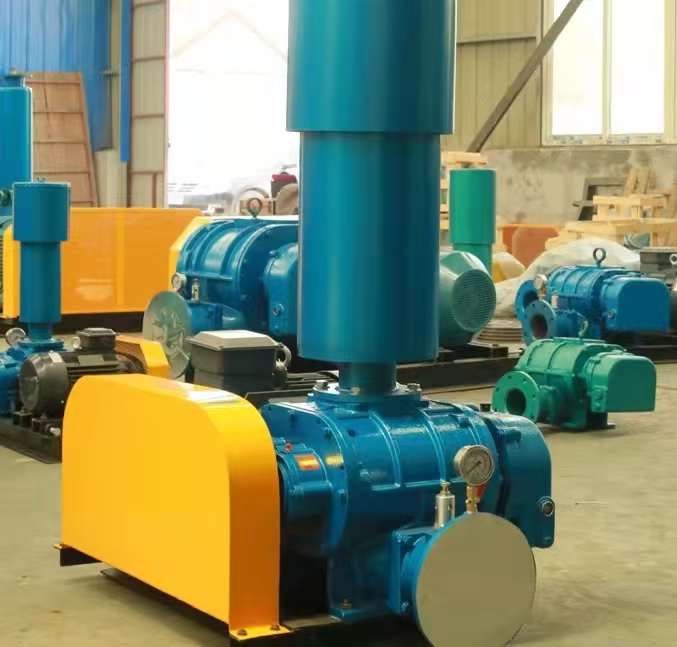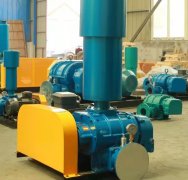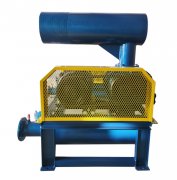High pressure fans and Roots fans are two different types of fans that are suitable for different industrial scenarios. They have significant differences in working principles, structural characteristics, performance parameters, and other aspects. Here is a detailed comparison:
---

**1、 Comparison Table of Core Differences**
|* * Comparison item * * | * High pressure fan (multi-stage centrifugal) * * | * Roots blower (volumetric) * *|
|------------------|--------------------------------|-------------------------------|
|* * Working principle * * | Centrifugal force is generated by high-speed rotating impeller to compress gas | Gas is pushed through rotor engagement without internal compression|
|* * Pressure range * * | * * 0.5~3 bar (single-stage) * *, multi-stage can reach * * 10 bar * * | * * 0.1~1.5 bar * * (high-pressure type can reach * * 2 bar * *)|
|* * Flow Range * * | * * Large Flow * * (10-1000 m3/min) | * * Medium and Small Flow * * (1-200 m3/min)|
|* * Efficiency * * | High (70-85) | Low (50-70), efficiency decreases under high pressure|
|* * Noise * * | Low (75-85 dB) | High (85-100 dB), requires muffler|
|* * Maintenance cost * * | Low (simple structure) | High (gears and bearings are prone to wear)|
|* * Price * * | High (precision impeller requirement) | Low (simple structure)|
|* * Applicable scenarios * * | Air compressors, boiler blowing, pneumatic conveying | Sewage treatment, aquaculture, vacuum conveying|
---
**2、 Detailed differentiation analysis**
**1. Working principle**
-High pressure fan (centrifugal)**
-The gas enters the high-speed rotating impeller and is compressed and thrown out under the action of centrifugal force.
-Continuous flow, with pressure determined by the number of impeller stages and rotational speed.
-Roots blower**
-Two rotors mesh and rotate, pushing gas from the inlet to the outlet.
-Pulsating airflow, with pressure determined by system back pressure (without internal compression).
**2. Pressure and flow characteristics**
|* * Features * * | * High pressure fan * * | * Roots blower * *|
|----------------|---------------------------|---------------------------|
|* * Pressure flow curve * * | Flow rate decreases significantly with increasing pressure | Flow rate remains relatively constant and is not affected by pressure|
|* * Applicable pressure * * | Suitable for medium and high pressure (>1 bar) | Suitable for medium and low pressure (<1.5 bar)|
|* * Applicable flow rate * * | Suitable for high flow rate (>50 m3/min) | Suitable for medium and small flow rate (<50 m3/min)|
**3. Energy efficiency and operating costs**
-High pressure fan:
-High efficiency (especially in high flow conditions), long-term operation is more energy-efficient.
-However, high-speed impellers require high balance and complex maintenance.
-Roots blower:
-Low efficiency (some energy is used to overcome rotor friction), and energy consumption increases dramatically at high pressure.
-But the structure is simple and the initial investment is low.
**4. Noise and vibration**
-High pressure fan:
-Low noise (mainly high-frequency airflow noise) and minimal vibration (dynamic balance optimization).
-Roots blower:
-The noise is loud (rotor meshing impact+airflow pulsation), and a muffler needs to be installed.
-The vibration is more obvious (especially for old equipment).
---
**3、 Selection suggestions**
**When choosing a high-pressure fan (centrifugal)**
-Requires high pressure (>1.5 bar) or high flow rate (>50 m3/min).
-Sensitive to * * noise * * (such as urban sewage treatment plants).
-Long term operation, pursuing * * low energy consumption * * (such as air compression systems).
**The situation of choosing Roots blower**
-Stable flow rate is required (such as gas supply to the aeration tank).
-Pressure requirement * *<1.5 bar * *, flow rate * *<50 m3/min * *.
-Due to limited budget or working conditions containing dust and humid gases (Roots blowers are more resistant to dirt).
---
**4、 Frequently Asked Questions and Answers**
**Q1: Can Roots blower replace high-pressure blower**
-* * Cannot * *. Roots blower has limited pressure (generally ≤ 1.5 bar), high efficiency under high-pressure conditions, and is prone to overheating and damage.
**Q2: Which type of fan is more durable**
-High pressure fans (centrifugal) have a longer lifespan (without mechanical friction), but Roots fans have a simple structure and are easy to maintain.
**Q3: How to reduce the noise of Roots blower**
-Install * * muffler * *, use * * three bladed rotor * *, and use * * soundproof cover * *.
---
**5、 Summary**
|* * Fan Type * * | * * Advantages * * | * * Disadvantages * * | * * Typical Applications * *|
|-------------|--------------------------|--------------------------|--------------------------|
|* * High pressure fan * * | Rate, high pressure, low noise | High price, complex maintenance | Air compressor, pneumatic conveying|
|Roots blower * * | Simple structure, stable flow rate, dirt resistance | High noise, low energy efficiency under high pressure | Sewage treatment, aquaculture|
According to the comprehensive selection of pressure, flow rate, energy consumption, and budget, if there are special requirements (such as explosion-proof and anti-corrosion), customized models are required.



